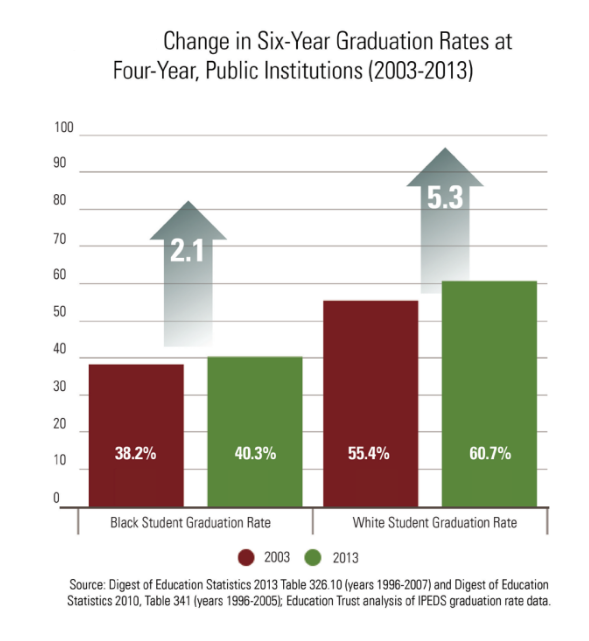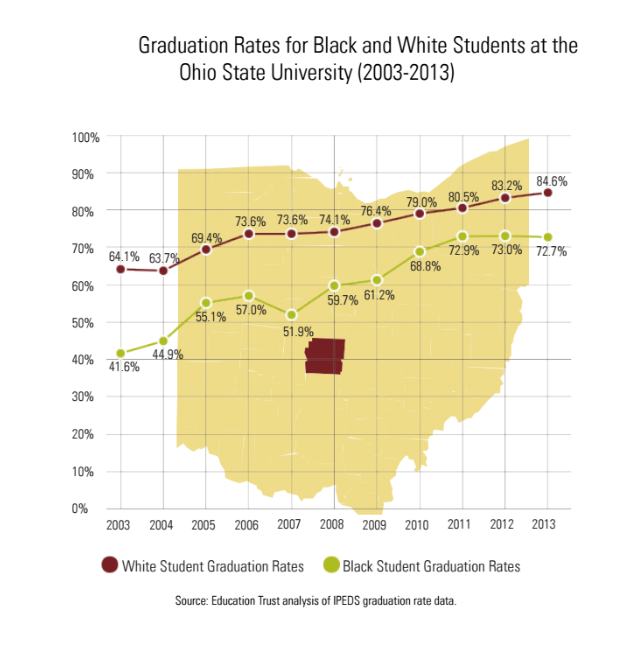You have /5 articles left.
Sign up for a free account or log in.
Most public colleges have improved overall graduation rates during the last decade, a new study found. But gaps between the academic success of black students and that of white students continue to widen.
Graduation rates improved between 2003 and 2013 at nearly 70 percent of the public, four-year institutions examined by Education Trust, a nonprofit group. At more than half of those colleges and universities, however, the gains among black students trailed those of white students. And at one-third of the colleges that improved overall graduation rates, the rates of black students actually fell or remained stagnant.
“It’s not an encouraging finding,” said Andrew Nichols, co-author of the report and director of higher education research and data analytics at Education Trust. “It underscores the need to really dig into data and to look at success of particular subgroups, not just at overall success. We’re seeing improvements, but the improvements among black students have not occurred at a pace that enables institutions to close the gap.”
Other recent research also has found that black students at predominantly white institutions continue to lag behind white students. A study released last week by the University of Pennsylvania's Center for the Study of Race and Equity in Education concluded that black male athletes, in particular, are graduating at rates much lower than their peers. At the 65 wealthiest institutions in the National Collegiate Athletic Association, according to the report, just over half of black male athletes graduate in six years, compared to 75 percent of undergraduates overall.
Like the Education Trust study, the Center for the Study of Race and Equity in Education's report found that overall graduation rates have increased, but not at a pace that would help close existing gaps between racial groups.
“There’s been a slight increase in graduation rates, about three percentage points, but it’s been across the board, so that doesn’t narrow the racial equity gaps,” Shaun Harper, the center's executive director, said last week. “That increase is perhaps good news for universities, but the racial disparity still remains.”
Education Trust, which advocates for the academic success of low-income and minority students, began comparing the graduation rates of white students and minority students last year. In a report released in December, the group found that 77 percent of the 255 institutions included in the study increased graduation rates of their minority students between 2003 and 2013, narrowing the completion gap by about one percentage point in 10 years.
The new study focuses on the graduation rates specifically of black students, comparing them to both the rates of white students and students overall. At the 232 institutions that have improved overall graduates during the past decade, graduation rates for white students improved 5.6 percentage points. The rate for black students improved 4.4 percentage points.
The researchers also compared graduation rates of black students at similar institutions and found that the rates vary widely.
At the University of Missouri, where student protests over racial inequality erupted last semester, graduation rates of black students “have barely budged over the last 10 years,” the report notes, dropping less than one percentage point. For white students, the graduation rate actually increased by three points, increasing the gap between the two groups from 10.6 points in 2003 to 14.6 in 2013.
The report compares those rates to that of North Carolina State University, where graduation rates for black students improved by 12.5 percentage points over 10 years, narrowing the gap between black students and white students to 10 points.
“Even though both institutions are similar in size, have similar admission requirements and serve nearly identical percentages of students who receive Pell [Grants] and identify as black, NC State has a better track record of success for their black students,” the researchers wrote.
At Rutgers University at New Brunswick, the gap between black and white students narrowed from 13.4 points in 2003 to 8.1 points in 2013. During that same time frame, the gap between black and white students at the similarly sized Purdue University more than doubled to 19.7 percentage points.
The report also highlights initiatives at a handful of institutions that seem to have helped improve the graduation rates of black students in the last decade.
“Institutional leaders can’t be satisfied with overall gains, or even just with any increase for black students,” José Luis Santos, vice president of higher education policy and practice at Education Trust, said. “Leaders must strive for accelerated gains among black students so they can catch up to their peers. Thankfully, there are institutions across the country that are showing the way forward.”
At Ohio State University, the graduation rate for black students has increased by 25.6 percentage points since 2003 and the gap between black and white students has narrowed by 8.6 points. The report suggests that those gains can be partially credited to the university’s Young Scholars Program, which connects low-income, mostly black middle school students to a college-preparation curriculum and provides a need-based scholarship if they later enroll at the university.
Once at Ohio State, the students also meet once a month with a success coach. The report suggested that mentoring and advising focused on black students has been an effective way to close the achievement gap between black and white students.
At the same time, “there is no silver bullet,” Nichols said.
“Typically when I ask college presidents or individuals responsible for student success what they’re doing, I get a laundry list of things similar to the programs we’ve seen be successful,” he said. “But some of these institutions are not having that same success. There are some things that we know work: remediation, better advising and course scheduling, providing cleaner pathways toward a degree. All these things are important and helpful, but you can’t just do them. You have to do them well.”










